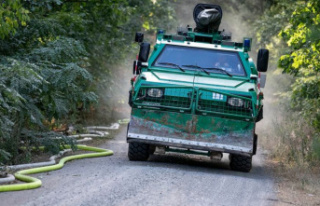What do climate change and the corona pandemic have in common? At first glance: nothing. The climate has been changing since the beginning of the earth's history, but recently, thanks to humans, it has been changing many times faster. The corona virus is a pathogen that – according to the currently most likely theory – recently jumped from animals to humans and is also threatening this species. Just stop in time lapse. The learning curve went accordingly. Corona will not disappear anymore, we have to live (learn) with the virus, was the realization.
When it comes to climate change, it's not that simple. Global warming is much slower and depends on various factors. While the virus spread across the globe within a few months, man-made climate change began as early as the 18th century (or man's sedentariness - climate researchers sometimes disagree). More than two centuries passed before the consequences were also felt in the Global North.
It took at least as long for the international community to understand that something had to be done to combat climate change. At the end of the 1980s, the German Physical Society and the German Meteorological Society put Germany on the alert with a devastating prognosis. The first report by the Intergovernmental Panel on Climate Change (IPCC) in 1990 shook the world.
More than 30 years, six climate reports and numerous environmental disasters later, the climate learning curve still lags behind that of the coronavirus. If you like, the world community is still in the first phase of combat. The motto is that we can still stop climate change. To this end, 55 countries agreed in Paris in 2016 to reduce global warming to a minimum. The 1.5 degree target should prevent the worst catastrophes. This also requires a decarbonization of our planet, in other words: we have to reduce our CO2 emissions. Did that work?
According to the Federal Statistical Office, emissions in the EU fell by 32 percent between 1990 and 2020. Germany, which is responsible for most of the greenhouse gases in the EU, was able to surpass that. The Federal Republic has saved 41 percent in the last 30 years. However, the effect remains marginal if emissions continue to rise worldwide. Given the seriousness of the situation, there are still loopholes that are slowing down the fight against climate change. One of them is the Energy Charter, a relic from the 90's protecting energy companies. In the past, companies have boycotted such climate-friendly projects because they felt at a competitive disadvantage. The authors of the latest climate report also criticized this. The fact that climate protection is progressing so slowly is due on the one hand to the lack of resources and on the other hand to a lack of political will.
The United States is one of the best examples of this. Under ex-President Donald Trump, the climate goals agreed in Paris were met with criticism at most. Now the Senate, led by Joe Biden, has passed a "historic climate package" that was also praised by the "New York Times". The package of measures trumps above all with the incredible sums that the Biden government wants to provide for climate protection. In terms of content, however, the whole thing leaves little impression. Not least because the local economic and environmental politicians have been arguing and lecturing about the expansion of renewable energies for years.
With 400 billion dollars, Biden now wants to promote e-mobility in his country. In addition, fossil energies are to be pushed back and higher taxes are to be levied for their promotion. The proceeds will go to renewables. This more or less marks the end of the good news from the climate package. It is questionable whether the investment in e-mobility is worthwhile, because the production and disposal of the batteries is neither climate-friendly nor finally clarified. The fact that the United States has backed away from its goal of halving its CO2 emissions by 2030 is also problematic. Instead, emissions are to be 40 percent below 2005 levels by the end of the decade. At that time, greenhouse gas emissions were around the same as they are today, at over 5,500 billion tons a year. In addition, companies are to receive new leases for oil and gas production in the Gulf of Mexico and Alaska.
Together with China, the USA is one of the countries with the highest CO2 emissions worldwide. Biden's climate package is therefore a step in the right direction, despite some cutbacks. The US President will certainly no longer slow down climate change and its consequences with the billion-euro package. The consequences of climate change are already too serious for that.
The number of environmental disasters has quintupled since the 1970s. That's what the weather organization (WMO) found out in Geneva. An analysis of 500 extreme weather events and associated studies, which journalists from the British "Guardian" evaluated together with climate researchers, shows that they are related to climate change. According to this, around 71 percent of the weather events studied are more likely or even aggravated by man-made climate change. This is made clear by the heat waves. 93 percent are related to climate change, 68 percent for droughts and 56 percent for floods. The consequences: According to study authors, climate change has in the last caused a third of heat-related deaths in three decades.
As early as 2014, the director of the Research Center for Disaster Epidemiology, Debby Guha Sapir, predicted: "There is a clear trend of increasing weather and climate-related disasters." According to experts, this is due to the fact that more and more people are living in endangered areas, especially in coastal or river regions, as the example of the Ahr Valley shows. But even in the dry inland, people are not immune to catastrophes. The burning Grunewald speaks for itself.
We can no longer stop climate change. But, similar to the coronavirus, we can prepare for its consequences. This does not mean that we should give up the fight and throw all previous measures overboard. But research shows that all packages and targets can only be damage control. We must now acknowledge that we have to live with climate change. Time for phase two of combat.
There is already a pioneer. In New Zealand, the government has published an adjustment plan. "The climate is changing and there will be some effects that we cannot avoid," said New Zealand's climate minister James Shaw. With the almost 200-page paper, citizens can find out about the consequences of climate change. The coastal regions are particularly in focus. According to the report, 675,000 New Zealanders live in flood-prone regions. Another 72,065 residents live in areas affected by rising sea levels. In the document, the government set out the measures it intends to take over the next six years to make the country climate-proof. Future construction projects should be planned in such a way that climate changes or catastrophes do not cause too much damage. For this purpose, citizens must be informed about the risks on site. The plan also includes guidelines to protect the environment and resources.
Information portals about endangered regions and the consequences of climate change are also to be created for the population. There is something similar in Germany. The federal state of North Rhine-Westphalia has passed the first independent climate adaptation law nationwide. According to the 15-point offensive, climate impacts and adaptation options should be regularly examined and developed. An advisory board will be set up to implement the climate adaptation strategy. A similar program also exists at EU level.
However, these adaptation measures are not really well known. And the political debate also shows that governments are currently still too busy discussing solutions to climate change. While the discussions revolve around renewable energies as measures to reduce emissions, the question of how the population can protect themselves from the consequences of climate change is far too neglected. Comprehensive information options, which are also tailored to the individual regions, are missing. They would not only be helpful to prevent damage in the event of possible climate catastrophes, but also to increase awareness and knowledge of such events among the population. Acknowledging that we have to live with climate change and preparing the population for it would be the change of strategy derived from studies and climate events in recent years.
Sources: Federal Environment Agency, Federal Statistical Office, "New York Times", The Federal Government, Federal Institute for Research on Building, Urban Affairs and Spatial Development, State Government of North Rhine-Westphalia, Government website of New Zealand, "The Guardian", Deutsche Welle












